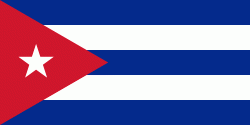Sagua La Grande (Sagua la Grande)
 |
Sagua la Grande was founded in 1812 and established as a municipality in 1842. By the beginning of the 20th century, the city and its port (Isabela de Sagua), were an important commercial center. Presently, its economy is based on the sugar, chemical, mechanical, and food industries. Cattle raising and fishing are other important economic activities.
Two city historians are notable. Antonio Miguel Alcover Beltrán left to the inheritance of the events related to the 19th century thanks to his personal interrogations to each one of the authors of history; and at the moment Pedro Suárez Rojo (Tintín) has been in charge to rescue all 20th century and leaves from the 21st century in his famous “Tintin Collection” that includes newspapers, books, photos, films and videos of all the historical events of the referred time.
Until the 1977 municipal reform, it was divided into the barrios of Baire, Calabazar de Sagua (now part of Encrucijada), Chinchila, Este, General Nodarse, Isabela de Sagua, Jumagua, Malpáez, Oeste and Sitiecito.
Map - Sagua La Grande (Sagua la Grande)
Map
Country - Cuba
 |
 |
| Flag of Cuba | |
The territory that is now Cuba was inhabited by the Ciboney people from the 4th millennium BC with the Guanahatabey and Taíno peoples until Spanish colonization in the 15th century. From the 15th century, it was a colony of Spain, and slavery was abolished in 1886, remaining a Spanish colony until the Spanish–American War of 1898, when Cuba was occupied by the United States and gained independence in 1902. In 1940, Cuba implemented a new constitution, but mounting political unrest culminated in a coup in 1952 and the subsequent dictatorship of Fulgencio Batista, which was later overthrown in January 1959 by the 26th of July Movement during the Cuban Revolution, which afterwards established communist rule under the leadership of Fidel Castro. The country was a point of contention during the Cold War between the Soviet Union and the United States, and a nuclear war nearly broke out during the Cuban Missile Crisis of 1962. Following the collapse of the Soviet Union, Cuba faced a severe economic downturn in the 1990s, known as the Special Period. In 2008, Fidel Castro resigned after 49 years of leadership of Cuba and was replaced by his brother Raúl Castro.
Currency / Language
| ISO | Currency | Symbol | Significant figures |
|---|---|---|---|
| CUC | Cuban convertible peso | $ | 2 |
| CUP | Cuban peso | $ | 2 |
| ISO | Language |
|---|---|
| ES | Spanish language |















